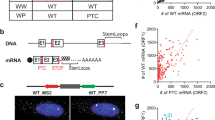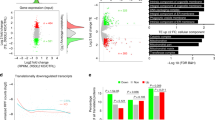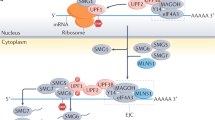Abstract
The nonsense-mediated mRNA decay (NMD) pathway selectively eliminates aberrant transcripts containing premature translation termination codons and regulates the levels of a number of physiological mRNAs. NMD modulates the clinical outcome of a variety of human diseases, including cancer and many genetic disorders, and may represent a target for therapeutic intervention. Here, we have developed a new multicolored bioluminescence-based reporter system that can specifically and effectively assay NMD in live human cells. Using this reporter system, we conducted a robust high-throughput small-molecule screen in human cells and, unpredictably, identified a group of cardiac glycosides, including ouabain and digoxin, as potent inhibitors of NMD. Cardiac glycoside–mediated effects on NMD are dependent on binding and inhibiting the sodium-potassium ATPase on the plasma membrane and subsequent elevation of intracellular calcium levels. Induction of calcium release from the endoplasmic reticulum also leads to inhibition of NMD. Thus, this study reveals intracellular calcium as a key regulator of NMD and has implications for exploiting NMD in the treatment of disease.
This is a preview of subscription content, access via your institution
Access options
Subscribe to this journal
Receive 12 print issues and online access
$209.00 per year
only $17.42 per issue
Buy this article
- Purchase on Springer Link
- Instant access to full article PDF
Prices may be subject to local taxes which are calculated during checkout




Similar content being viewed by others
References
Kervestin, S. & Jacobson, A. NMD: a multifaceted response to premature translational termination. Nat. Rev. Mol. Cell Biol. 13, 700–712 (2012).
Schoenberg, D.R. & Maquat, L.E. Regulation of cytoplasmic mRNA decay. Nat. Rev. Genet. 13, 246–259 (2012).
Bruno, I.G. et al. Identification of a microRNA that activates gene expression by repressing nonsense-mediated RNA decay. Mol. Cell 42, 500–510 (2011).
Gardner, L.B. Nonsense-mediated RNA decay regulation by cellular stress: implications for tumorigenesis. Mol. Cancer Res. 8, 295–308 (2010).
Frischmeyer, P.A. & Dietz, H.C. Nonsense-mediated mRNA decay in health and disease. Hum. Mol. Genet. 8, 1893–1900 (1999).
Ellis, M.J. et al. Whole-genome analysis informs breast cancer response to aromatase inhibition. Nature 486, 353–360 (2012).
Holbrook, J.A., Neu-Yilik, G., Hentze, M.W. & Kulozik, A.E. Nonsense-mediated decay approaches the clinic. Nat. Genet. 36, 801–808 (2004).
Kuzmiak, H.A. & Maquat, L.E. Applying nonsense-mediated mRNA decay research to the clinic: progress and challenges. Trends Mol. Med. 12, 306–316 (2006).
Pastor, F., Kolonias, D., Giangrande, P.H. & Gilboa, E. Induction of tumour immunity by targeted inhibition of nonsense-mediated mRNA decay. Nature 465, 227–230 (2010).
Gudikote, J.P. & Wilkinson, M.F. T-cell receptor sequences that elicit strong down-regulation of premature termination codon-bearing transcripts. EMBO J. 21, 125–134 (2002).
Paillusson, A., Hirschi, N., Vallan, C., Azzalin, C.M. & Muhlemann, O. A GFP-based reporter system to monitor nonsense-mediated mRNA decay. Nucleic Acids Res. 33, e54 (2005).
Gammon, S.T., Leevy, W.M., Gross, S., Gokel, G.W. & Piwnica-Worms, D. Spectral unmixing of multicolored bioluminescence emitted from heterogeneous biological sources. Anal. Chem. 78, 1520–1527 (2006).
Zhang, X.D. et al. Robust statistical methods for hit selection in RNA interference high-throughput screening experiments. Pharmacogenomics 7, 299–309 (2006).
Prassas, I. & Diamandis, E.P. Novel therapeutic applications of cardiac glycosides. Nat. Rev. Drug Discov. 7, 926–935 (2008).
Brumbaugh, K.M. et al. The mRNA surveillance protein hSMG-1 functions in genotoxic stress response pathways in mammalian cells. Mol. Cell 14, 585–598 (2004).
Yamashita, A., Ohnishi, T., Kashima, I., Taya, Y. & Ohno, S. Human SMG-1, a novel phosphatidylinositol 3-kinase-related protein kinase, associates with components of the mRNA surveillance complex and is involved in the regulation of nonsense-mediated mRNA decay. Genes Dev. 15, 2215–2228 (2001).
Mendell, J.T., Sharifi, N.A., Meyers, J.L., Martinez-Murillo, F. & Dietz, H.C. Nonsense surveillance regulates expression of diverse classes of mammalian transcripts and mutes genomic noise. Nat. Genet. 36, 1073–1078 (2004).
Gardner, L.B. Hypoxic inhibition of nonsense-mediated RNA decay regulates gene expression and the integrated stress response. Mol. Cell. Biol. 28, 3729–3741 (2008).
Wang, D., Wengrod, J. & Gardner, L.B. Overexpression of the c-myc oncogene inhibits nonsense-mediated RNA decay in B lymphocytes. J. Biol. Chem. 286, 40038–40043 (2011).
Hu, J., Li, Y. & Li, P. MARVELD1 inhibits nonsense-mediated RNA decay by repressing serine phosphorylation of UPF1. PLoS ONE 8, e68291 (2013).
Huang, L. et al. RNA homeostasis governed by cell type-specific and branched feedback loops acting on NMD. Mol. Cell 43, 950–961 (2011).
Yepiskoposyan, H., Aeschimann, F., Nilsson, D., Okoniewski, M. & Muhlemann, O. Autoregulation of the nonsense-mediated mRNA decay pathway in human cells. RNA 17, 2108–2118 (2011).
Dostanic-Larson, I., Van Huysse, J.W., Lorenz, J.N. & Lingrel, J.B. The highly conserved cardiac glycoside binding site of Na,K-ATPase plays a role in blood pressure regulation. Proc. Natl. Acad. Sci. USA 102, 15845–15850 (2005).
Lingrel, J.B. The physiological significance of the cardiotonic steroid/ouabain-binding site of the Na,K-ATPase. Annu. Rev. Physiol. 72, 395–412 (2010).
Ye, J., Chen, S. & Maniatis, T. Cardiac glycosides are potent inhibitors of interferon-β gene expression. Nat. Chem. Biol. 7, 25–33 (2011).
Smith, T.W. & Haber, E. Digoxin intoxication: the relationship of clinical presentation to serum digoxin concentration. J. Clin. Invest. 49, 2377–2386 (1970).
Menger, L. et al. Cardiac glycosides exert anticancer effects by inducing immunogenic cell death. Sci. Transl. Med. 4, 143ra199 (2012).
Colak, D., Ji, S.J., Porse, B.T. & Jaffrey, S.R. Regulation of axon guidance by compartmentalized nonsense-mediated mRNA decay. Cell 153, 1252–1265 (2013).
Giorgi, C. et al. The EJC factor eIF4AIII modulates synaptic strength and neuronal protein expression. Cell 130, 179–191 (2007).
Long, A.A. et al. The nonsense-mediated decay pathway maintains synapse architecture and synaptic vesicle cycle efficacy. J. Cell Sci. 123, 3303–3315 (2010).
McIlwain, D.R. et al. Smg1 is required for embryogenesis and regulates diverse genes via alternative splicing coupled to nonsense-mediated mRNA decay. Proc. Natl. Acad. Sci. USA 107, 12186–12191 (2010).
Tarpey, P.S. et al. Mutations in UPF3B, a member of the nonsense-mediated mRNA decay complex, cause syndromic and nonsyndromic mental retardation. Nat. Genet. 39, 1127–1133 (2007).
Wong, J.J. et al. Orchestrated intron retention regulates normal granulocyte differentiation. Cell 154, 583–595 (2013).
Eom, T. et al. NOVA-dependent regulation of cryptic NMD exons controls synaptic protein levels after seizure. Elife 2, e00178 (2013).
Johansson, M.J. & Jacobson, A. Nonsense-mediated mRNA decay maintains translational fidelity by limiting magnesium uptake. Genes Dev. 24, 1491–1495 (2010).
You, Z. et al. CtIP links DNA double-strand break sensing to resection. Mol. Cell 36, 954–969 (2009).
Gross, S. & Piwnica-Worms, D. Real-time imaging of ligand-induced IKK activation in intact cells and in living mice. Nat. Methods 2, 607–614 (2005).
You, Z., Bailis, J.M., Johnson, S.A., Dilworth, S.M. & Hunter, T. Rapid activation of ATM on DNA flanking double-strand breaks. Nat. Cell Biol. 9, 1311–1318 (2007).
Chen, X., Paudyal, S.C., Chin, R.I. & You, Z. PCNA promotes processive DNA end resection by Exo1. Nucleic Acids Res. 41, 9325–9338 (2013).
Nociari, M.M., Shalev, A., Benias, P. & Russo, C. A novel one-step, highly sensitive fluorometric assay to evaluate cell-mediated cytotoxicity. J. Immunol. Methods 213, 157–167 (1998).
Acknowledgements
We thank P. Wu and X. Chen for their contributions in the early stage of this project. We are grateful to O. Mühlemann (University of Bern) for providing the pβ510 reporter construct, which we used to obtain the TRB minigene reporter sequence for our reporter construction, and R. Mecham (Washington University School of Medicine) for providing primary mouse skin fibroblasts. This study was supported by a Molecular Imaging Center grant from the US National Institutes of Health to Washington University and The University of Texas MD Anderson Cancer Center (P50 CA94056, D.P.-W.), by a Washington University Molecular Imaging Center Pilot Research Project grant (Z.Y.), by a grant from the US National Institutes of Health (R01GM098535, Z.Y.) and by an Interdisciplinary Research Initiative grant from the Children's Discovery Institute of Washington University (MC-II-2012-215, Z.Y. and D.P.-W.). The High-Throughput Screening Core at the Washington University School of Medicine is supported in part by the Siteman Cancer Center (Cancer Center Support grant P30 CA91842 from the US National Cancer Institute).
Author information
Authors and Affiliations
Contributions
Z.Y. and D.P.-W. conceived the project and supervised the studies. A.N. and Z.Y. designed and performed the experiments. E.J. contributed to the bioluminescence imaging and the analysis of screen and imaging data. J.M. assisted with the high-throughput chemical screen. P.N. assisted with the analysis of the screen results. R.W.M. provided expression constructs for rat Na+/K+-ATPase α subunits and technical advice. A.N., Z.Y. and D.P.-W. wrote the manuscript.
Corresponding authors
Ethics declarations
Competing interests
The authors declare no competing financial interests.
Supplementary information
Supplementary Text and Figures
Supplementary Figures 1–5 and Supplementary Tables 1–3 (PDF 3965 kb)
Rights and permissions
About this article
Cite this article
Nickless, A., Jackson, E., Marasa, J. et al. Intracellular calcium regulates nonsense-mediated mRNA decay. Nat Med 20, 961–966 (2014). https://doi.org/10.1038/nm.3620
Received:
Accepted:
Published:
Issue Date:
DOI: https://doi.org/10.1038/nm.3620
This article is cited by
-
Nonsense-mediated RNA decay and its bipolar function in cancer
Molecular Cancer (2021)
-
Targeting natural splicing plasticity of APOBEC3B restricts its expression and mutagenic activity
Communications Biology (2021)
-
Nonsense-mediated RNA decay in the brain: emerging modulator of neural development and disease
Nature Reviews Neuroscience (2018)
-
A pan-cancer genome-wide analysis reveals tumour dependencies by induction of nonsense-mediated decay
Nature Communications (2017)
-
A human microprotein that interacts with the mRNA decapping complex
Nature Chemical Biology (2017)



